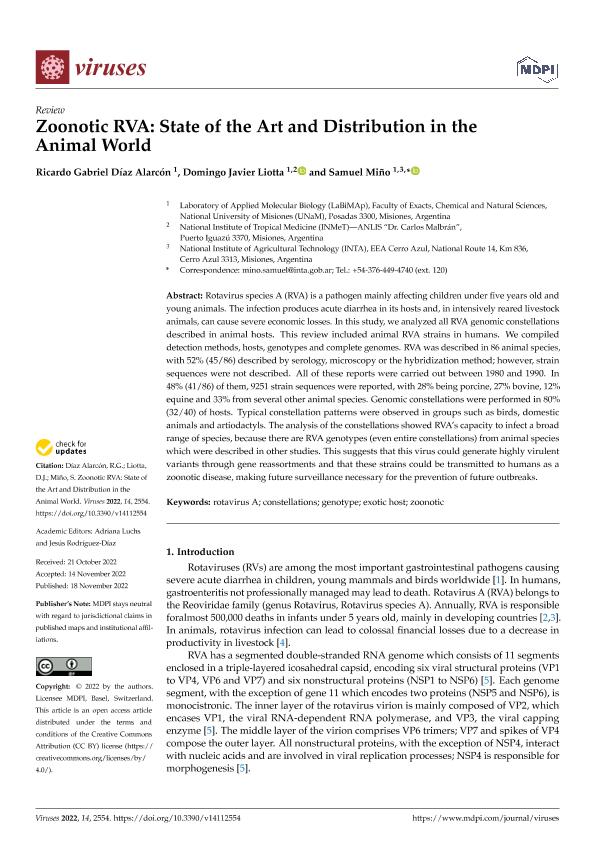Mostrar el registro sencillo del ítem
dc.contributor.author
Díaz Alarcón, Ricardo Gabriel

dc.contributor.author
Liotta, Domingo Javier

dc.contributor.author
Miño, Orlando Samuel

dc.date.available
2024-01-18T13:21:32Z
dc.date.issued
2022-11
dc.identifier.citation
Díaz Alarcón, Ricardo Gabriel; Liotta, Domingo Javier; Miño, Orlando Samuel; Zoonotic RVA: State of the Art and Distribution in the Animal World; MDPI; Viruses; 14; 11; 11-2022; 1-26
dc.identifier.issn
1999-4915
dc.identifier.uri
http://hdl.handle.net/11336/224065
dc.description.abstract
Rotavirus species A (RVA) is a pathogen mainly affecting children under five years old and young animals. The infection produces acute diarrhea in its hosts and, in intensively reared livestock animals, can cause severe economic losses. In this study, we analyzed all RVA genomic constellations described in animal hosts. This review included animal RVA strains in humans. We compiled detection methods, hosts, genotypes and complete genomes. RVA was described in 86 animal species, with 52% (45/86) described by serology, microscopy or the hybridization method; however, strain sequences were not described. All of these reports were carried out between 1980 and 1990. In 48% (41/86) of them, 9251 strain sequences were reported, with 28% being porcine, 27% bovine, 12% equine and 33% from several other animal species. Genomic constellations were performed in 80% (32/40) of hosts. Typical constellation patterns were observed in groups such as birds, domestic animals and artiodactyls. The analysis of the constellations showed RVA’s capacity to infect a broad range of species, because there are RVA genotypes (even entire constellations) from animal species which were described in other studies. This suggests that this virus could generate highly virulent variants through gene reassortments and that these strains could be transmitted to humans as a zoonotic disease, making future surveillance necessary for the prevention of future outbreaks.
dc.format
application/pdf
dc.language.iso
eng
dc.publisher
MDPI
dc.rights
info:eu-repo/semantics/openAccess
dc.rights.uri
https://creativecommons.org/licenses/by/2.5/ar/
dc.subject
CONSTELLATIONS
dc.subject
EXOTIC HOST
dc.subject
GENOTYPE
dc.subject
ROTAVIRUS A
dc.subject
ZOONOTIC
dc.subject.classification
Virología

dc.subject.classification
Ciencias Biológicas

dc.subject.classification
CIENCIAS NATURALES Y EXACTAS

dc.title
Zoonotic RVA: State of the Art and Distribution in the Animal World
dc.type
info:eu-repo/semantics/article
dc.type
info:ar-repo/semantics/artículo
dc.type
info:eu-repo/semantics/publishedVersion
dc.date.updated
2024-01-18T10:35:53Z
dc.journal.volume
14
dc.journal.number
11
dc.journal.pagination
1-26
dc.journal.pais
Suiza

dc.journal.ciudad
Basilea
dc.description.fil
Fil: Díaz Alarcón, Ricardo Gabriel. Consejo Nacional de Investigaciones Científicas y Técnicas. Centro Científico Tecnológico Conicet - Nordeste; Argentina. Universidad Nacional de Misiones; Argentina
dc.description.fil
Fil: Liotta, Domingo Javier. Universidad Nacional de Misiones; Argentina. Dirección Nacional de Instituto de Investigación.Administración Nacional de Laboratorios e Institutos de Salud "Dr. Carlos G. Malbrán"; Argentina. Consejo Nacional de Investigaciones Científicas y Técnicas. Centro Científico Tecnológico Conicet - Nordeste; Argentina
dc.description.fil
Fil: Miño, Orlando Samuel. Universidad Nacional de Misiones; Argentina. Instituto Nacional de Tecnología Agropecuaria. Centro Regional Misiones. Estación Experimental Agropecuaria Cerro Azul; Argentina
dc.journal.title
Viruses
dc.relation.alternativeid
info:eu-repo/semantics/altIdentifier/doi/http://dx.doi.org/10.3390/v14112554
Archivos asociados
